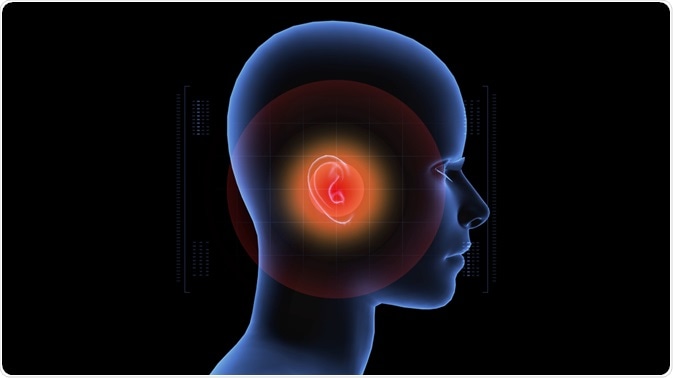The development of cancer in the middle and inner ear is rare. In the UK, out of a million people, less than one is diagnosed with middle ear cancer annually. Cholesterol granulomas, cholesteatoma, polyps, and facial nerve neuroma are uncommon benign tumors associated with the middle ear.

Ear. Image Credit: Myvector/Shutterstock.com
The Middle and Inner Ear
There are three tiny bones within the middle ear—malleus, incus, and stapes, which pass the sound vibrations to the inner ear.
The inner ear comprises of the cochlea, vestibule, and semicircular canals. The spiral-shaped cochlea has many hair-like small nerves; it helps to convert sound vibrations into nerve impulses that are transmitted to the brain. We are able to hear, because of the nerves present in the cochlea. The vestibule and semicircular canals have receptors for hearing and balance.
Types of Middle and Inner Ear Cancers
Middle and inner ear cancers can be classified into five types:
- Basal cell carcinoma (BCC)
- Squamous cell carcinoma (SCC)
- Melanoma
- Adenoid cystic carcinoma (ACC)
- Adenocarcinoma
Basal cell carcinoma (BCC): A non-melanoma type of skin cancer, BCC is the most common skin cancer. Also termed as rodent ulcers, it generally affects people with a fair skin tone. Men are more prone than women. High-risk populations include individuals using sunbeds, those living in geographic areas with more exposure to sunlight, and those who already have a history of BCC. Though not infectious, there is a possibility of developing BCC when ulcers, burns, or scars are present in an area of skin that is already damaged. BCC can develop anywhere on the body. Areas such as the ears, face, neck, and head, which have the most exposure to sunlight, are common areas for developing BCC.
Squamous cell carcinoma (SCC): Temporal bone cancer occurs in one of 5000–20,000 cases. Annually, it accounts for an incidence level of about 1–6 cases out of 1 million. Individuals may be diagnosed with temporal bone SCC when they are 50 or 60 years old. In the middle ear and external auditory canal, the development of malignant tumors is rare; however, when they develop, morbidity and mortality rates are higher. SCC develops more frequently in the auditory canal than in the middle ear.
Melanoma: Though moles (i.e. pigmented spots on the skin) are mostly harmless, when their total number exceeds 100, chances of developing melanoma is high. Initial signs can be one or more skin lesions that are atypical. Knowing one’s skin and identifying changes in any of the moles present are important to diagnose melanoma early.
The ABCDE of Melanoma: If a mole is Asymmetrical, or the Border of the mole is not well-defined, or there is a Color variation across areas, or the Diameter (size) of the mole is more than 6 mm and/ or there is Evolution of the mole (i.e. difference of the mole over time in terms of color, shape, or size), these are all warning signs for melanoma.
Adenoid Cystic Carcinoma (ACC): A unique and rare cancer form, ACC is unpredictable. The growth of the cancer is generally slow; however, it is gradual and progressive over time. Most often, it occurs in the oral cavity (primary tumors); however, it can also develop in other organs of the body. Usually, cancer occurs in glands where the fluid is secreted, such as sweat glands, excretory glands, and tear glands. It can also occur in the ears, skin, brain, breast, lungs, and nose. In rare cases, ACC develops in the external ear canal.
Adenocarcinoma: The mucosa in the middle ear can develop tumors that are rare. As they are rare, classifying them becomes difficult. Signs and symptoms include a bleeding mass in the external auditory meatus or erosion of the mastoid bone.
Stages of Middle and Inner Ear Cancer
Physicians decide on the stage of cancer after examining the size of the tumor and the extent of its spread. When cancer is rare, developing a system for cancer staging is difficult. For ear cancer, numerous types of staging systems are employed by physicians. During the early stages of the disease, the tumor is small and remains in the area where it has originated. The stage of cancer is said to be advanced if cancer spreads to other areas in the body.
When cancer cells spread from their place of origin to other parts of the body, we term the condition as metastasis. The TNM staging system is used for defining the cancer stages of the middle ear and the ear canal and helps as a guide for the treatment as well as the prognosis of the disease.
References
Further Reading
Last Updated: Feb 26, 2021